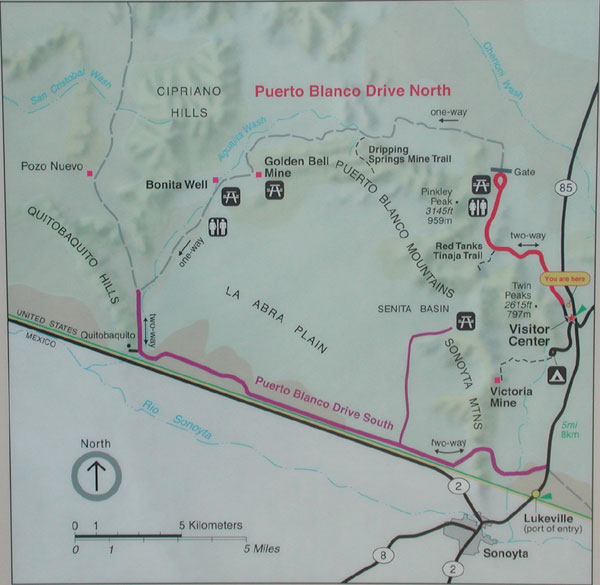
Desert Wild Flower Reports ¦ Birds ¦ Mammals ¦ Cacti ¦ Shrubs and Trees

Organ Pipe National Monument ranks among the most spectacular treasures within the US National Park system and is recognized as a component of an International Biosphere Reserve that includes adjacent areas of northwestern Mexico. There are three kinds of giant columnar cacti, colorful and fantastically rugged mountains and desert solitude for everyone. Add to that some of the most spectacular sunsets anywhere.
Organ Pipe N.P. is located on the US-Mexico border some 140 miles south of Phoenix or 130 miles west of Tucson, Arizona making it a considerable drive from more well traveled routes. This is a huge park stretching more than 35 km from north to south and more than 40 km east to west at its widest. In addition there are many other worthy destinations in the vicinity: First and foremost are the International Biosphere units across the border in Mexico (Pinacate, Gran Desierto and vast estuaries at the northern end of the Sea of Cortez). Then Cabeza Prieta National Wildlife Refuge and the Camino de Diablo to the west of Organ Pipe run along the US side of the border adjacent to Gran Desierto. Kitt Peak with its astronomical observatories sets about 80 miles east towards Tucson. What this really all means is that the visitor can spend many days if not weeks exploring the area, or like myself, will be drawn to return again and again.
The camp ground ("Twin Peaks") and visitor's center are great starting points for your adventure. The park entrance fee is $8 and camp fee $12 - restrooms with water but no showers. Many of the most characteristic birds, animals, cacti and shrubs flourish within the camping area. Somehow the animals just know that visitors pose no threat and so they come up close making for easy observation.
The 'must' visit locations within Organ Pipe are Senita Basin the only place to see Senita Cactus and Elephant Trees, Estes Canyon and trail to Bull Pasture, Ajo Mountain Drive, Arch Canyon and Alamo Canyon. Check the National Park Service website to get more travel info and planning tips.
The town of Ajo lies 30 miles to the north where there are guest houses and plenty of lodging. RV parks with more substantial creature comfort facilities are available in Why and Lukeville just outside the park boundaries.
BirdsCommon birds in general order of Abundance. A complete list is available at the
park visitor center.
|

Gambel's Quail carries a distinctive feather atop its head.  
|
Mammals
|
Sponsored Links |
![]()
CactiIn order of Abundance:
|
Mammillaria cactus are quite variable and a number of purported varieties have been named.. |
![]()
|
I found the following shrubs along the Red Tanks Tinaja Trail,
mostly in order of Abundance:
|
Sponsored Links |
Mojave Desert Star |
Browneyes |
Desert Bladderpod |
Desert Tobacco |
Narrow Leaf Popcorn Flower Cryptantha |
Desert Chicory |
Orange Fiddleneck |
Creosote Bush |
Triangle-leaf Bursage |
Purple Mat |
London Rocket |
Sahara Mustard |
Yellowcomet |
Coulter's Lyrepod |
Coulter's Globe Mallow |
Ajo Lily |
Parish's Desert-Thorn |
Desert Thorn Bush |
California Poppy |
White Easter-bonnets |
Whitlowgrass |
Lupine |
Blue Phacelia |
Notch-leaved Phacelia |
Canyon Ragweed |
Red Maids |
Comb Bur |

Sonoran Desert Naturalist
Home Page
Desert Places
Field Guide